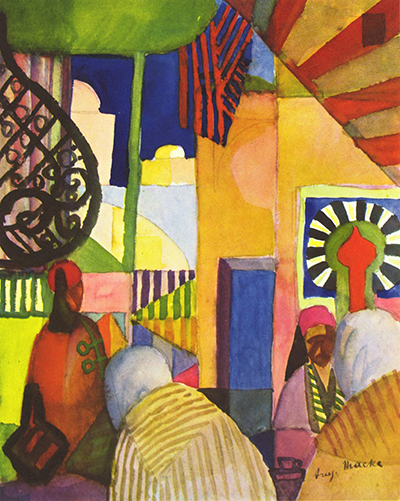In the Bazaar is a bright, charming watercolour painting by August Macke as part of his North African-inspired series of artworks.
Greens and yellows dominate the scene. Several figures can be found in the foreground, whilst traditional architecture covers the rear of the piece. At the furthest back is a small slither of sky, delivered in a dark blue. This composition is more up-close, concentrating on the vibrant, hectic every day life that constantly intrigued this artist. The overlapping layers of colour also help to give an impression of an over crowded street, perhaps a back street just away from a busy market. Watercolour paintings are easily identifiable by small watermarks which inevitably settle in corners of the planes of colour. With relatively little detail, Macke's approach was well suited to this medium.
Watercolours offered the artist a way of being able to work from any location during his travels around Northern Africa. He could bring just a few items with him, all relatively light, and this allowed him to set up to work whenever the urge took him. He loved the culture of this region and would work spontaneously, just as a photographer might capture something in the present day. There were several features to this region that particularly interested him - the colours were bright and clear, the architecture was stunning and historic, and the lives being led were honest and passionate. He would attempt to delve deeper into this culture during his time travelling around and use his work as a form of documenting what he saw.
The figures in this scene are anonymous, with detail kept to a minimum just as the artist would do with most of his figures. Many of the forms have a small outline, most likely from the strokes of a pencil. This would have been done first as the artist laid out the composition before then adding blocks of watercolour to complete the piece. In some cases he would add diagonal stripes in order to create patterned designs for the local's clothing. But elsewhere, things were particularly simple.




